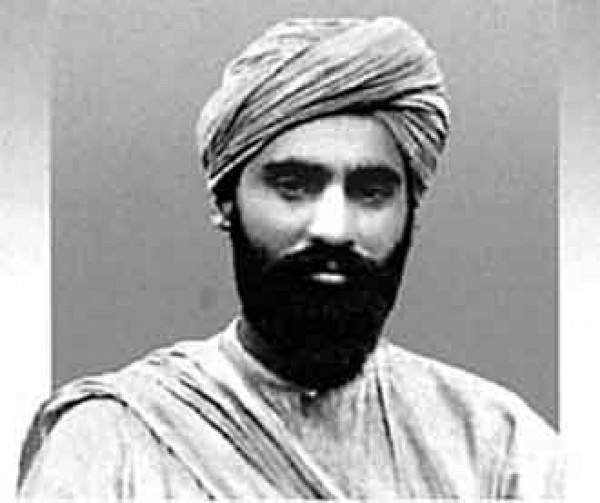Sadhu Sundar Singh
<img style= vertical-align bottom title= Sadhu Sundar Singh src= http www propheticvoice co uk images masters feet Sadhu Sundar Singh jpg alt= Sadhu Sundar Singh height= 207 width
Sadhu Sundar Singh


India, the country that gave birth to great religions – Hinduism, Buddhism, Jainism and Sikhism – continues to be a fertile ground for those seeking spiritual sustenance, a meaning to life, in general. The image of the Sadhu in his orange robes is a common sight. And it was this very image that I encountered the other day that brought to mind the life and times of the Indian Christian Ascetic – Sadhu Sundar Singh 1889-1929.
Here is a brief history of His Life and Times taken from http://www.tentmaker.org/biographies/singh.htm . This article was primarily written by Edward T. Babinski, with further editing and additions by Mercy Aiken.
Sundar Singh was lauded by 20th century evangelical Christians for converting to Christianity around the turn of the century. Even in the 1970s Sundar was highly thought of by evangelical Christians. At that time I heard a Christian radio dramatization of the story of Sundar’s miraculous conversion and his dangerous preaching journeys to India and Tibet, and I bought two books that told his story at evangelical Christian bookstores. The evangelical Christian apologist, Josh McDowell of Josh McDowell ministries, cited Sundar’s conversion in the first and second editions of McDowell’s book, Evidence That Demands a Verdict. While reading the evangelical versions of Sundar’s life and teachings, I never once ran across Sundar’s universalistic statements, not until I read Sundar’s own works, along with some of the in-depth biographies that had been written about him nearer his own day.
Sundar was raised a member of the Sikh religion. (Sikhism is a sect within Hinduism that was founded about 1500 A.D. that teaches belief in one God and rejects the caste system and idolatry.) Prior to his conversion, Sundar attended a primary school run by the American Presbyterian Mission where the New Testament was read daily as a “textbook.” Sundar “refused to read the Bible at the daily lessons…To some extent the teaching of the Gospel on the love of God attracted me, but I still thought it was false.” Though according to another testimony, Sundar confessed, “Even then, I felt the Divine attractiveness and wonderful power of the Bible.”
In the midst of such confusion and while only fourteen years old, his mother died, and Sundar underwent a crisis of faith. His mother was a loving saintly woman and they were very close. In his anger, Sundar burned a copy of one of the Gospels in public.
“Although I believed that I had done a very good deed by burning the Bible, I felt unhappy,” he said. Within three days Sundar Singh could bear his misery no longer. Late one night in December 1903, he rose from bed and prayed that God reveal himself to him if he really existed. Otherwise — “I planned to throw myself in front of the train which passed by our house.” For seven hours Sundar Singh prayed. “O God, if there is a God, reveal thyself to me tonight.” The next train was due at five o’clock in the morning. The hours passed.
Suddenly the room filled with a glow. A man appeared before him. Sundar Singh heard a voice say, “How long will you deny me? I died for you; I have given my life for you.” He saw the man’s hands, pierced by nails.
Jesus was the last person Sundar was looking for. After all, Jesus was the ‘foreign god’ of the Christian teachers at his school… Amazed that his vision had taken the unexpected form of Jesus, Sundar was convinced in his heart that Jesus was the true Savior, and that He was alive. Sundar fell on his knees before Him and experienced an astonishing peacefulness which he had never felt before. The vision disappeared, but peace and joy lingered within him.
To meet Christ was only the beginning for Sundar Singh. He was a Sikh. Sikhs had endured terrible persecutions in their early history. As a consequence they were fiercely loyal to their faith and to each other. Conversion to Christianity was considered treachery. Now every effort was made to woo or coerce Sundar Singh back to his ancestral faith.
Despite his family’s please, bribes, and threats, Sundar wanted to be baptized in the Christian faith. After his father spoke words of official rejection over him, Sundar became an outcast from his people. He cut off the hair he had worn long like every Sikh man. Against great opposition, he was baptized on his birthday in 1905, in an English church in Simla.
Conventional Indian churches were willing to grant him a pulpit, but their rules were foreign to his spirit. Indeed, he felt that a key reason the gospel was not accepted in India was because it came in a garb foreign to Indians. He decided to become a sadhu, so that he could dedicate himself to the Lord Jesus. He was convinced that this was the best way to introduce the Gospel to his people since it was the only way which his people were accustomed to. As a sadhu, he wore a yellow robe, lived on the charity of others, abandoned all possession and maintained celibacy. In this lifestyle, he was free to devote himself to the Lord.
Dressed in his thin yellow robe, Sundar Singh took to the road and began a life of spreading the simple message of love and peace and rebirth through Jesus. He carried no money or other possessions, only a New Testament.
“I am not worthy to follow in the steps of my Lord,” he said, “but like Him, I want no home, no possessions. Like Him I will belong to the road, sharing the suffering of my people, eating with those who will give me shelter, and telling all people of the love of God.”
Sundar journeyed much. He traveled all over India and Ceylon. Between 1918-1919, he visited Malaysia, Japan and China. Between 1920-1922 he went to Western Europe, Australia and Israel. He preached in many cities; Jerusalem, Lima, Berlin and Amsterdam among others. Despite his growing fame, Sundar retained a modest nature, desiring only to follow Jesus’ example: to repay evil with kindness and to win over his enemies by love. This attitude often caused his enemies to feel ashamed of themselves, and caused even his father to become a Christian later in life, and to support Sundar in ministry.
He was quite independent of outward Church authority in all his religious life, thought, and work. He dropped out of a Christian seminary that he briefly attended. Neither did he attach much importance to public worship because in his experience the heart prays better in solitude than in a congregation. He was also highly displeased with what he found when he toured western nations that for centuries had the benefit of the Bible and whose central figure of worship was Jesus. Sundar proclaimed almost prophetic denunciations upon Western Christianity, and laughed at the way the West looked down upon religious men of the East as mere “pagans” and “heathens.”
“People call us heathens,” he said in a conversation with the Archbishop of Upsala. “Just fancy! My mother a heathen! If she were alive now she would certainly be a Christian. But even while she followed her ancestral faith she was so religious that the term ‘heathen’ makes me smile. She prayed to God, she served God, she loved God, far more warmly and deeply than many Christians.”
On another occasion, Sundar said, “I have seen many Christian women, but none of them came up to my mother.” And, conversing with the Archbishop of Canterbury, Sundar said: “If I do not see my mother in heaven, I shall ask God to send me to hell so that I may be with her.” Sundar also made plain his view that, “There are many more people among us in India who lead a spiritual life than in the West, although they do not know or confess Christ. It is of course true that people who live in India worship idols; but here in England people worship themselves, and that is still worse. Idol-worshippers seek the truth, but people over here, so far as I can see, seek pleasure and comfort. The people of the West understand how to use electricity and how to fly in the air. The men of the East have sought the truth. Of the three Wise Men who went to Palestine to see Jesus not one was from the West.‘”
He travelled India and Tibet, as well as the rest of the world, with the message that the modern interpretation of Jesus was sadly watered down. Sundar visited Tibet every summer. In 1929, he visited that country again and was never seen again.
Sundar’s Faith for All Mankind
Few Christians know that Sundar was not afraid to raise his voice in favor of “universalism.” He could never deny to all non-Christians the possibility of entering heaven. In 1925 Sundar wrote, “If the Divine spark in the soul cannot be destroyed, then we need despair of no sinner… Since God created men to have fellowship with Himself, they cannot for ever be separated from Him… After long wandering, and by devious paths, sinful man will at last return to Him in whose Image he was created; for this is his final destiny.”
In February, 1929, the year Sundar disappeared on his final missionary trip to Tibet, he was interviewed by several theology students in Calcutta, India, where he answered their questions:
(Question #1) What did the Sadhu think should be our attitude towards non-Christian religions? — The old habit of calling them ‘heathen’ should go. The worst ‘heathen’ were among us [Christians]…
(Question #2) Who were right, Christian Fundamentalists or Christian Liberals? – Both were wrong. The Fundamentalists were uncharitable to those who differed from them. That is, they were unchristian. The Liberals sometimes went to the extent of denying the divinity of Christ, which they had no business to do.
(Question #3) Did the Sadhu think there was eternal punishment? — There was punishment, but it was not eternal…Everyone after this life would be given a fair chance of making good, and attaining to the measure of fullness the soul was capable of. This might sometimes take ages.”
Last updated: 18th May 2012 by

